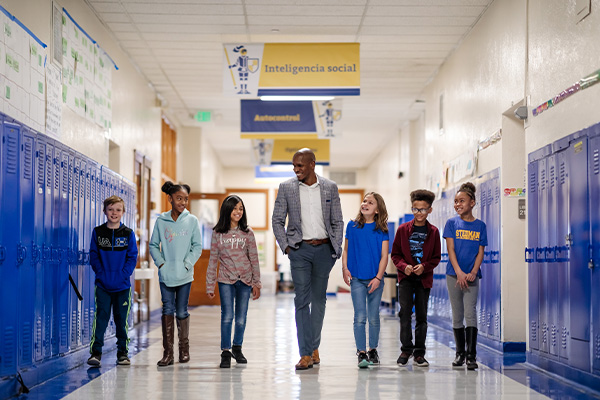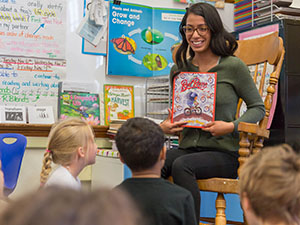Have Questions? We have answers.
Contact Us

UNICEF estimates that there are nearly 240 million children with disabilities around the globe. These children have dreams and ambitions for their futures as much as anyone. A quality education with inclusion in standard classrooms is needed to help them develop their knowledge and skills, so they too can reach their full potential.
Why inclusive practices are essential in education
 Inclusive practices in education examine how lessons, programs, classrooms, and schools are constructed. Inclusive education means creating an atmosphere where all students have the opportunity to participate and learn. Inclusive practices are essential in education because every student deserves to experience and learn in an atmosphere of respect where they can develop and maintain friendships with other students and teachers in their schools and communities.
Inclusive practices in education examine how lessons, programs, classrooms, and schools are constructed. Inclusive education means creating an atmosphere where all students have the opportunity to participate and learn. Inclusive practices are essential in education because every student deserves to experience and learn in an atmosphere of respect where they can develop and maintain friendships with other students and teachers in their schools and communities.
Inclusive education proposes that all children have a right to the same education. It’s not something that can or should be earned, and it’s not something that a child must prepare and get ready for. It is an inherent right.
What is inclusive education?
Simply put, it is the best way to provide all kids a fair chance to attend school and learn and develop the skills needed to thrive. Inclusive education means the integration or inclusion of all students in the same classrooms and in the same schools, without exception. This includes the integration or inclusion of students with special needs.
It also means a student’s “particularities” should be regarded as elements of diversity instead of a problem. This translates into real learning opportunities for kids who have often been excluded, including those with disabilities and those who speak a language other than English.
Inclusive educational systems understand the importance of the unique contributions students from diverse backgrounds bring to the classroom, benefiting the class as a whole. This kind of educational process identifies obstacles that any student may face and works to remove those barriers.
Inclusive teaching means all students are included in the classroom routines. It is, in fact, considered a crime not to accept them or even provide for their needs in any classroom or school.
A lot of creative thinking is required on the part of instructors to produce an environment where all kids feel comfortable enough to participate. Instructors will need to learn how to teach in new and unique ways to meet the needs of all students in their classrooms so that every child can be involved.
Broadly stated, inclusive education beliefs and principles maintain that all kids:
- Can learn
- Can attend age-appropriate regular classrooms
- Should receive a curriculum that is relevant and needs-driven
- Should receive suitable educational programs
- Should have opportunities to partake in co-curricular and extracurricular activities
- Should have collaboration and cooperation at home, school, and in the community
It is the foundation that creates a lifetime of acceptance and appreciation for all students.
What is an inclusive classroom, and why is it important?
An inclusive classroom is designed to include students with disabilities, impairments, and special needs in age-appropriate, general education environments so they can learn among their peers.
The definition is evolving; however, it means to be inclusive in many other situations, not just special education.
An inclusive classroom addresses the needs of all students including those:
- With intellectual, emotional, developmental and physical disabilities
- Who speak languages other than English
- With different religious backgrounds
- From diverse social and economic backgrounds
- With various sexual orientations
An inclusive classroom ensures all students are treated respectfully and have access to general education and technology. Inclusive teaching practices close the gap between the “haves” and the “have-nots,” and reduces the impact of prejudices in society.
What does an inclusive classroom look like?
In an inclusive classroom, all students experience respect and have a sense of belonging. When inclusive teaching practices are used, you can have/expect:
- High expectations for all students
- Instruction is based on school- or state-adopted standards
- Individualized support to be available when needed
In an inclusive classroom, the uniqueness of every child is honored. Effective inclusive practices address the services provided rather than where the services are offered. The values associated with inclusive teaching revolve around respect and relationships while the needs of all students are addressed.
How to introduce inclusive strategies to your classroom
Inclusive learning means all students have access to flexible learning opportunities. They are given effective methods to assist them in achieving their educational goals in environments where a sense of belonging is experienced. In an inclusive educational environment, all students, – regardless of disability or ability –, experience learning in the same age-appropriate environment.
How is all of this accomplished in a classroom? These four specific strategies can be implemented to help you meet the needs of all students in a classroom.
- Create an accessible classroom by utilizing the Universal Design for Learning Principles
- Use a variety of teaching methods, giving each child the opportunity to learn in ways that work best for them
- Familiarize yourself with each of your student’s Individualized Education Programs (IEPs) and 504s
- Create behavior management plans to prepare for times when students exhibit disruptive behaviors
When introducing inclusive education strategies into your classroom, start small. Begin with a single lesson or activity. Build upon that success, branching out to other areas of the curriculum. Remember that every guideline does not apply to every single lesson. Guidelines are only applicable to the relevancy of your learning goals.
ACUE (Association of College and University Educators) offers 10 inclusive teaching practices than can be used immediately in the planning and implementation of classroom activities.
Do children leave regular classrooms for instruction with inclusive education?
Inclusive education means that kids are educated in regular classrooms; however, it doesn’t mean that a child cannot leave the classroom for individualized instruction. A child may need one-on-one support in a specific subject area, which may occur during regular class time. With inclusive teaching methods, serious thought must be given to how the support is to be provided, in and out of the regular classroom. It does not mean, however, that students needing support are grouped together and placed in a separate classroom for all or part of a school day.
How can teachers determine if inclusive practices are working?
In an inclusive teaching environment, all kids and their families are equally valued and deserve respect and access to the same educational opportunities. But how do you know if the strategies you are using are working for all students and their families?
In classrooms where inclusive teaching practices have been employed, students should experience increases in these areas:
- Communication and social skills
- Literacy skills
- IEPs
- Focused learning time
- Relationships and friendships
Special education teachers in inclusive classrooms are to conduct regular assessments to ensure students are meeting their academic goals. Lessons must also be evaluated periodically to establish that they are adequately challenging to the student without being overwhelming.
Students requiring and receiving supportive services should feel self-confident and independent in a standard educational setting while support services are utilized. Periodic IEP meetings with students, their families, and staff should take place to ascertain whether changes should be made to the student’s IEP.
Metropolitan State University of Denver has over 90 degree programs for undergraduate students and 10 graduate programs. We are one of the area’s most innovative universities, and from online classes to campus-based options with flexible schedules, you will find something to help you achieve your goal with MSU Denver.
Reach out to an admissions counselor today to start planning your degree and take that next step toward career advancement with a completed college degree.
Read about how an endowed scholarship is paving the way for special education teachers.


0 responses to “Why Inclusive Practices Are Essential in Education”